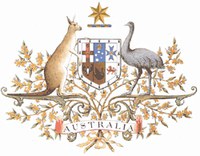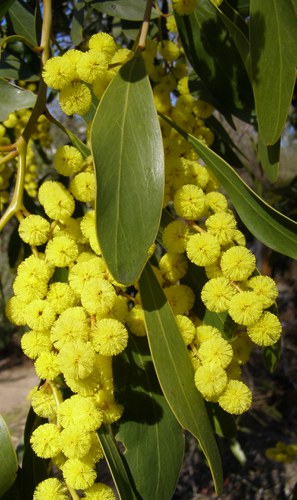1992 & 1988 & 1984 – Proclamations by Australia’s Governors-General
The following describes three proclamations that are relevant to the celebration of National Wattle Day: the proclamation of National Wattle Day in 1992, the proclamation of Acacia pycnantha as Australia’s national floral emblem (1988) and the 1984 proclamation of the national colours – that had more to do with the traditional sporting colours of green and gold than wattles. The latter is presented to complete the picture as people often assume that the national colours were inspired by the golden wattle. There is no doubt however that the national colours (1984) display the colours of the golden wattle in flower proclaimed four years later.
History
In 1992, the first day of September each year was officially proclaimed ‘National Wattle Day’ throughout Australia by the Governor-General of Australia.
Before then Wattle Day, first celebrated from NSW to Victoria and South Australia on 1 September 1910, came to be celebrated on different days in different states and territories to match the peak wattle flowering in that part of Australia… from June in north Qld to late September in Tasmania.
Wattle days have also been celebrated for different reasons over the last century. For example, they were linked during WW1 to patriotism, a reminder of home for those fighting wars overseas and fundraising for related community causes.
Perhaps Dr Rod Panter summed it up best when he wrote in 1997 that:
“Wattle and Wattle Day can symbolise virtually anything we want, but they relate generally to Spring, being Australian, the Australian environment, and history. Spring has many positive values such as optimism, bounty and abundance, reliability, colour, and so on.
We can celebrate our ‘Australianness’ on Wattle Day in quite a different way from Anzac Day, which in recalling past wars glorifies Australian qualities of courage and mateship.
Wattle day, by contrast, looks forward (to Spring) and can celebrate the nation’s undoubted qualities of good humour, fairness, generosity, informality and democracy.”
1995 Rod Panter ‘Australia’s Wattle Day’ P2H20 (1)
http://www.wattleday.asn.au/about-wattle-day/autralias-wattle-day-history-1st-september/in-the-beginning/edit
National Wattle Day – 1992
There was no one date for a national Wattle Day celebration as this required a long-awaited agreement among the Commonwealth and States to unify Australia’s Wattle Day as the First Day of Spring (1st September) in every State and Territory. This took place in 1992 at the urging of Maria Hitchcock, Ian McNamara, presenter and Executive Producer of ABC’s radio program ‘Australia All Over’, and petitions signed by members of the Society for Growing Australian Plants’.
Official Proclamation
1 September has officially been National Wattle Day since 1992
(Before then, Australians in different States and Territories celebrated wattle day on different days between July and September.)
Commonwealth of Australia Gazette, No. S 240, Monday, 24 August 1992

PROCLAMATION of National Wattle Day
Commonwealth of Australia
By His Excellency the Governor-General of the Commonwealth of Australia
BILL HAYDEN
Governor-General
I, WILLIAM GEORGE HAYDEN, Governor-General of the Commonwealth of Australia, acting with the advice of the Federal Executive Council, declare that 1 September in each year shall be observed as “National Wattle Day” throughout Australia and in the external Territories of Australia.
(L.S.) GIVEN under my Hand and the Great Seal of Australia on 23 June 1992
By His Excellency’s Command,
Nick Bolkus
Minister of State for Home Affairs
GOD SAVE THE QUEEN

Note: About 1990 wattle became been part of the crest for the Governor-General of Australia – about 13 years after a single wattle blossom had been included in the insignia design for the Order Of Australia blossom in 1977.
National Wattle Day was proclaimed four years after Acacia pycnantha (Golden Wattle) became Australia’s floral emblem.
Australia’s national floral emblem – 1988
The proclamation of Golden Wattle, Acacia pycnantha as the national floral emblem, was made on the 1 September 1988 in Australia’s Bicentennial year.
The Gazettal is dated 1 September 1988, signed by the Governor General, Sir Ninian Stephen, on 19 August 1988.
Official Proclamation
Commonwealth of Australia Gazette, No. S 259 , Thursday , 1 September 1988

Commonwealth of Australia Gazette, No. S 259 Thursday 1 September 1988
PROCLAMATION
By His Excellency the Governor-General of the Commonwealth of Australia
N.M.STEPHEN
Governor-General
I, SIR NINIAN MARTIN STEPHEN, Governor-General of the Commonwealth of Australia, acting with the advice of the Federal Executive Council, hereby declare that the flowers of Acacia pycnantha, the plant known as Golden Wattle, however depicted, shall be the national floral emblem of Australia.
(L.S.) GIVEN under my hand and the Great Seal of Australia on 19 August 1988
By His Excellency’s Command,
ROBERT RAY
Minister of State for Home Affairs
GOD SAVE THE QUEEN
A wattle was chosen in part, because advocates such as school teacher, Maria Hitchcock, The Australian Native Plants Society and radio broadcaster Ian McNamara had lobbied state and federal government and raised public support with information that highlighted the rich history of wattle as an informal symbol of Australia from colonial times and its meaning for all Australians. For example in as early as 1891 the Australian Natives’ Association accepted ‘The wattle, in all its varieties’ as the Australian floral emblem, the Golden Wattle naturally gaining preeminence because of its universality’.
[‘Universality’ may have meant Acacia pycnantha represented most of Australia’s acacias found everywhere in Australia, because it has modified leaf stems (phyllodes) as an adaptation to Australia’s relatively hot, dry climate. Those well-known wattles with true leaves (that look a bit like ferns) such as the well-known wattle trees Silver Wattle (Acacia dealbata) and and Black Wattle (Acacia mearnsii) were only naturally growing in south-east Australia or in the case of another group small shrubs, in western Australia). The economic importance of Acacia pycnantha tannin-rich bark (for the important leather industry in colonial Australia), and its ‘uniquely spectacular’ blossom were also reasons for its choice back in 1891.
Golden Wattle (Acacia pycnantha)
Photo: ©S.D. Searle
Australia’s national colours of green and gold – 1984
© S. D Searle 2020
In 1984 Australia’s national colours were proclaimed to be green and gold.
This settled a long dispute as to whether the national colours should be red, white and blue, or green or blue together with gold.
The precise green and yellow references chosen are:
- Green: PANTONE®348C
- Gold: PANTONE®116C
Official Proclamation
Commonwealth of Australia Gazette, No. G 17 , Tuesday, 8 May 1984

Commonwealth of Australia Gazette, No. S 142, Thursday, 19 April 1984
PROCLAMATION
By His Excellency the Governor-General of the Commonwealth of Australia
N.M.STEPHEN
Governor-General
I, SIR N I N I A N M A R T I N S T E P H E N , Governor-General of the Commonwealth of Australia, acting with the advice of the Federal Executive Council, hereby declare
…: and
(e) that green and gold (Pantone Matching System
numbers 116C and 348C as used for printing on paper)
shall be the national colours of Australia for use on all
occasions on which such colours are customarily used.
(L.S.) G I V E N under my Hand and the Great Seal of Australia on 19 April 1984.
By His Excellency’s Command,
M. J. Y O U N G
Special Minister of State
